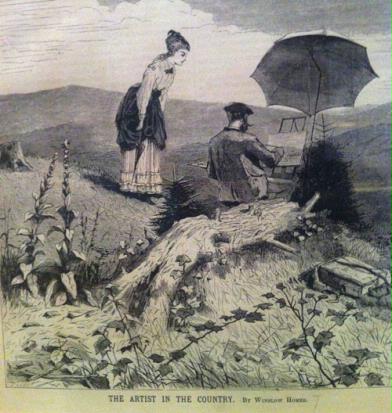
Though it remains something less than common knowledge, Massachusetts and New Hampshire played a decisive role in the birth and development of American painting.
Massachusetts landscapists Thomas Doughty and Alvan Fisher were the first American artists to trade portraiture and “history painting” (such as Leutze’s Washington Crossing the Delaware) for the raw beauty and terror of Nature. During the 1820s and ‘30s, they turned for subject matter to New Hampshire’s White Mountains, drawn in part by the sensational Willey disaster, in which an entire homesteading family vanished in a massive mudslide.
Although the “virgin wilderness” they sought had largely been cowed by commercial development even then, they nonetheless found expansive picturesque views coupled with rugged peaks and the occasional chasm. A Romantic painting of Crawford’s Notch by Fisher made a sensation when exhibited in Boston in 1834. But Thomas Cole’s celebrated 1839 work, A View of the Mountain Pass Called the Notch of the White Mountains, now in the National Gallery of Art in Washington, D.C., inaugurated a whole new ideal in American art.
The Museum of Fine Arts’ current exhibition Art of the White Mountains assembles a compact, broad, and diverse sampling of representative works from the museum’s permanent collection. The 21 pieces on display comprise plein-air (on-location) oil sketches, large-scale studio landscapes, photographs, rare books, watercolors, sketchbooks, pencil-and-ink drawings, lithographs, photogravures, and commercial art (if an engraving after Winslow Homer counts as “commercial”). The earliest work is an 1828 ink sketch by Cole and the latest is a 2012 etching titled Artist’s Bluff Peak by young artist Al Lewis, a member of the MFA’s staff.
Most of the heavy hitters — Cole, Champney, Cropsey, Gifford, Inness — are in the room, but so are lesser knowns, such as Ferdinand Richardt, David Johnson, and Edward Hill.
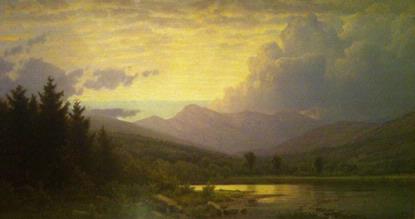
Sunset on Mount Chocurua (1873) by William Trost Richards claims pride of place on the main wall. It’s a munificent, glowing canvas combining accurate topography with the evocative romance of clouds of lavender and gold billowing above purple peaks and a honey-colored Saco River. Nearby, a small plein-air oil sketch of a New Hampshire lake by Doughty offers a harmonizing combination of enchantment and freshness that’s relatively rare for the genre.
A good many Hudson River School and White Mountain paintings indulge to a degree in the hazy opulence and composite pastoral valley views inspired as much by the conventions of classical European landscape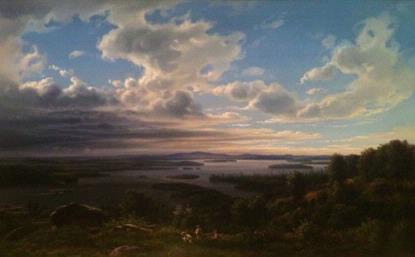 painting as by anything actually in New England. Sanford Robinson Gifford’s sublime An October Afternoon (1871) manages to raise the Claudean golden afternoon glow to majestic heights. As if to counter the tendency altogether, Richardt’s Lake Winnipesauke (1858) comes across like a sudden conviction. It’s at once bold, solid, deep, and bright (not to mention accurate), and it has a breathtaking sweep despite for once downplaying the mountainous heights by banishing them to the faraway distance. I only wished he’d left out the distracting figures picking berries in the foreground; the painting’s sense of scale is more than compelling without them.
painting as by anything actually in New England. Sanford Robinson Gifford’s sublime An October Afternoon (1871) manages to raise the Claudean golden afternoon glow to majestic heights. As if to counter the tendency altogether, Richardt’s Lake Winnipesauke (1858) comes across like a sudden conviction. It’s at once bold, solid, deep, and bright (not to mention accurate), and it has a breathtaking sweep despite for once downplaying the mountainous heights by banishing them to the faraway distance. I only wished he’d left out the distracting figures picking berries in the foreground; the painting’s sense of scale is more than compelling without them.
Equally atypical is Edward Hill’s Night Fishing on Profile Lake. In the smoky darkness of an overcast night, a fisherman stokes a fire in the bow of the boat (hmm…) while a second blaze on the lakeshore betokens a camp.
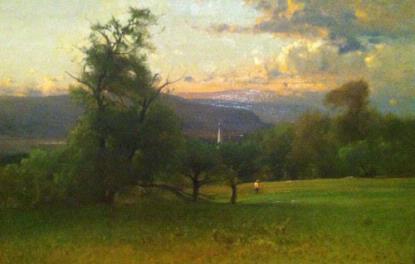
Close by, in George Inness’s simple and stunning The Church Spire (1875), it’s the gorgeous color-handling that beguiles, as well as the understated symbolism that pairs a lone white-shirted figure with the eponymous church spire rising above the emerald trees of the Intervale.
Benjamin Champney, often called “the father of White Mountain painting,” gets a whole wall and rightly so. A transplant from Boston, Champney is the only one of the early landscapists who actually bought property and lived in the White Mountains so he could paint there year round. Including an unusually pellucid view of Chocorua in cool blues and greens and a rare snow scene, Champney is represented by four paintings, only the largest of which (Mount Chocorua – An Afternoon of Fishing, 1869) is, thankfully, typical of this painter’s tendency toward stock bucolic images of picturesque trees and cattle.
For cattle, we must turn to Jasper Cropsey, whose star has been rising ever since the National Gallery in Washington D.C. began showcasing his massive Autumn on the Hudson River (1860). In keeping with his 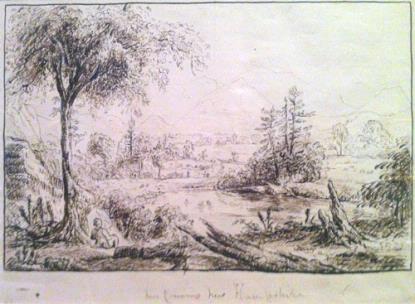 stature, Cropsey’s pastoral Mount Washington from Lake Sebago is suitably radiant, grand, and autumnal. Tellingly, right next to it, Cole’s diminutive pencil-and-ink plein-air sketch, Near Conway, New Hampshire (1828) more than holds its own.
stature, Cropsey’s pastoral Mount Washington from Lake Sebago is suitably radiant, grand, and autumnal. Tellingly, right next to it, Cole’s diminutive pencil-and-ink plein-air sketch, Near Conway, New Hampshire (1828) more than holds its own.
Throughout, curator Karen Quinn’s lively combinations and cross-pollinations shed light on the individual works and the period as a whole. But the most delightful revelation comes at the end, in her inspired pairing of modernist William Zorach and contemporary photographer Justin Kimball.
In his 1915 canvas, Zorach borrows the language of Fauvist Modernism to recast Randolph New Hampshire as a “cultivated Arcadia, with sensuous, Matisse-like nudes lounging in a bucolic landscape,” in Quinn’s words. In Kimball’s 2002 Deep Hole, New Hampshire, she finds “a testament to the continuing attraction of the state as a kind of arcadia or Garden of Eden into the twenty-first century.” Zorach composes his nude figures amid a New England recast as a harmonious ideal, while Kimball’s photograph seems to bear witness to the reality of the same, albeit in the form of very pale people interposed upon a rich topography of massive rocks and trees.
The Museum of Fine Arts’ “Art of the White Mountains” runs through July 7, 2013.
Images, top to bottom:
The Artist in the Country, engraving after Winslow Homer
Sunset on Mount Chocurua (1873) by William Trost Richards
Lake Winnipesauke (1858) by Ferdinand Richardt
The Church Spire (1875) by George Inness
Near Conway, New Hampshire (1828) by Thomas Cole


